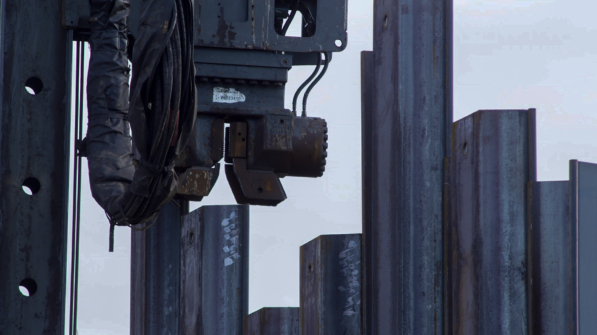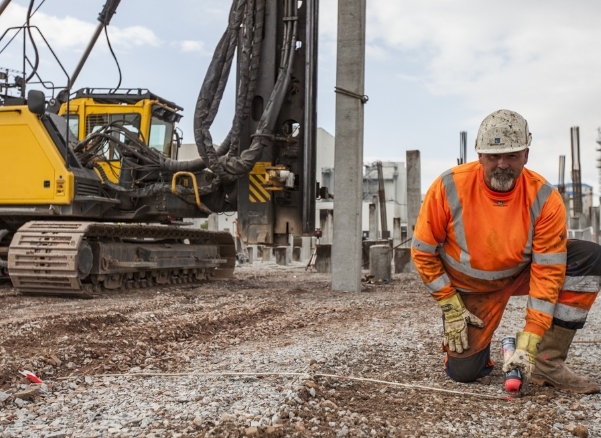How To Install Steel Sheet Piles?
To achieve the full performance of the sheet pile structure, sheet piles must be driven to the depth specified by the wall designer. This can be achieved through a number of methods – vibratory hammers, impact hammers, or a silent press if noise and vibration need to be eliminated. Corner and connector pieces are available for any sheet pile purchased, allowing the wall to follow the line laid out in the design.
Most scenarios will involve some preparatory work before you begin the construction of your sheet pile structure. Indeed, many sites will require excavation. To have more mobility in building, for burying anchors or ultimately changing the landscape, preparatory work will need to be done first.

Step-By-Step Installation Process
Once the preparatory work is completed, the installation of steel sheet piles can be achieved by the following steps:
- A temporary driving guide is highly recommended for building a straight wall. By assembling a driving guide before you begin the installation, you establish an accurate wall position and provide a surface to drive against that keeps the sheet piling plumb.
- Some forethought needs to be given to the sheet orientation before you begin. First, the most popular way to drive is with the male lock leading; the rationale being that the female lock tends to fill up with soil and hinder driving is used as the leading edge.
- Arrange the sheets in sections to check if the piles will interlock correctly or not.
- Hammer install the first sheet to the defined depth as per the design. You may want to mark your desired driving depth on your sheet to ensure sufficiently driven.
- Use vibratory hammers for installation but use impact hammers if the soil is hard or dense and the loss of penetration occurs.
- Use hydraulics to push the sheets into place if vibrations are prohibited at that particular site.
- After the first sheet is placed, drive the second sheet to interlocks with the first one.
- Corner pieces are available for any sheet pile that you might purchase. These pieces come in various configurations. Drive these just as you would a sheet pile.
- Alternatively, you can thread your corner piece on the leading lock of the last sheet to be driven and drive the sheet and the corner piece together.
- After you are satisfied that your corner is in position, drive your next box position, lining it up, using the corner’s male lock and your driving guide.
After you are satisfied that this sheet is adequately positioned, secure the sheet to your guide. - Repeat the process until the wall is completed.
- Use connector elements to maintain the integrity of the wall if it requires complex shapes.
How Deep Can Sheet Piles Go?
Let’s look at a case study. Chesterfield Associates Inc. commenced a project in November 2017 to replace the steel sheet piling on a pier at the Port Jefferson Ferry Terminal in New York state. The pier at Port Jefferson Ferry Terminal is about 300 feet long and 80 feet wide. The original structure, made of wood timbers, is about a hundred years old. It has been reframed at least a couple of times, most recently in the late 1980s.
A steel bulkhead ties into the landward end of the pier. Pile lengths required around the pier range from about 50 feet to 90 feet at the pier’s deepest point. The sheet piles installed in the 1980s had deteriorated in many places.
The new piles, at 0.625-inches thick, should have a longer service life of 50 to 60 years. This was the first job ever that Chesterfield Associates worked on that required two high mats. Moving the mats alone required six tractor-trailer loads. The longest sheet piles required for the depths of the project weighed eight tons a pair. Specialised stretch trailers transported two pairs at a time to the site.
Chesterfield Associates team extracted the old sheet piling from around the pier. About 40 metres of old piling was extracted and replaced at a time; the template used to hold the structure in line during this process is 40 feet long. Generally, the cycle of excavation, old pile extraction and new pile installation for the 40 feet would take two to three days, depending on bottom conditions; obstructions could add significantly to that time.
Requiring more power to install the new piling, the company rented a Model 50B vibratory hammer to drive up to 90 feet in the soil conditions at the pier. Sometimes when the old piling was being extracted, some of the previous structures moved into the path of the new piling. Divers were required to enter the water to deal with the obstructions.






